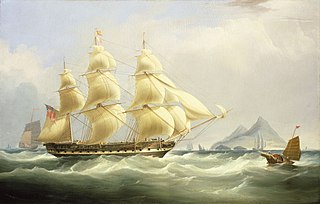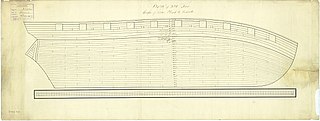Britannia may refer to any one of a large number of ships:
Numerous ships have been named Marquis of Rockingham, or Marquess of Rockingham:
HMS Charybdis was a Royal Navy Cruizer-class brig-sloop built by Mark Richards and John Davidson at Hythe, and launched in 1809. She captured two American prizes during the War of 1812 before she was laid up in 1815 and sold in 1819. She apparently then became the whaler Greenwich which made three voyages for Samuel Enderby & Sons and one for Daniel Bennett & Son. She was wrecked in the Seychelles in 1833 on her fourth whaling voyage.
Coromandel was the French prize Modeste, captured in 1793 and refitted at Chittagong, British India. She made two voyages transporting convicts to Port Jackson, the first for the British East India Company (EIC). A French privateer captured her in 1805 but she had returned to British hands before 1809. An American privateer captured her in 1814 but this time the British Royal Navy recaptured her within days. She foundered in Indian waters on 6 February 1821.
HMS Sylvia was an Adonis-class schooner of the Royal Navy during the Napoleonic War. She was built at Bermuda using Bermudan cedar and completed in 1806. She took part in one notable single-ship action in the East Indies in 1810. The Navy sold her in 1816 and she then became a merchantman. She was wrecked in 1823 on a voyage to West Africa.
A number of sailing vessels were named Alexander:
Numerous ships with the name Phoenix, for the constellation or the mythical bird, have sailed for the British East India Company (EIC) between 1680 and 1821:
HMS Gleaner was the mercantile ketch Gleaner, launched in 1802. She served the Royal Navy as the "hired ketch Gleaner" from 12 July 1808 until the Navy purchased her in 1809. Initially she served as a light vessel and survey vessel. From early 1811 to August 1811 she served in the Mediterranean, where she captured an Ottoman vessel. She then became a yard lighter and a light vessel again. Then in 1812 she was on the North American station where she participated in the capture of several merchant vessels. Next she returned to the Mediterranean where she captured a privateer. Finally, she served off the north coast of Spain where she was wrecked on 2 March 1814.

A number of ships with the name Asia served the British East India Company (EIC) as East Indiamen:
A number of sailing ships have been named Eliza.
Several vessels have been named Harriet, or Harriot:

HMS Derwent was launched in 1807 and later that year became one of the first ships sent by the British Royal Navy to suppress the slave trade.
Numerous vessels have borne the name Fame:
Several vessels have been named William Pitt for William Pitt, 1st Earl of Chatham (1708–1778), a.k.a. William Pitt the Elder, British prime minister (1766–1768) or William Pitt the Younger (1759–1806), son of the above and British prime minister.
Anacreon was launched in 1800 at Sunderland. She initially sailed between London and Minorca and then between 1804 and 1805 she served as an armed defense ship for the Royal Navy. She next became a London-based transport, and eventually traded from Liverpool to the Baltic and Canada. She was wrecked in 1823.
Lord Forbes was launched at Chester in 1803 as a West Indiaman. She soon became an "armed defense ship", but by 1805 had returned to being a West Indiaman. She made two voyages as an "extra" ship for the British East India Company (EIC). She continued trading with India until 1817 when she sustained damage on her way to Bengal. There she was surveyed, condemned and sold.
Norfolk was built in France in 1784 under a different name. The British captured her c. 1800 and she made some voyages as a West Indiaman. She also made a cruise as a privateer. Between 1803 and 1808 she served the Royal Navy as an armed defense and hired armed ship on the Leith Station. She spent her time escorting convoys in the North Sea and captured one French privateer. After her naval service, between 1808 and 1814 Norfolk was a London-based transport. From 1814 to 1820 she made four voyages as a whaler in the Southern Whale Fishery. She was last listed in 1823.
Paragon was launched at Whitby in 1800. Between 1803 and 1805 she served as an armed defense ship protecting Britain's coasts and convoys. She then served as a transport on the 1805 naval expedition to capture the Cape of Good Hope. Next, she returned to mercantile service and in 1814 a French privateer captured her, but the British Royal Navy recaptured her the next day. She sailed to India in 1818 under a license from the British East India Company (EIC}, and was wrecked in March 1819 while inbound to Calcutta.
Several vessels have been named Paragon:
Several ships have been named Hinchinbrooke or Hinchinbrook.
This page is based on this
Wikipedia article Text is available under the
CC BY-SA 4.0 license; additional terms may apply.
Images, videos and audio are available under their respective licenses.

